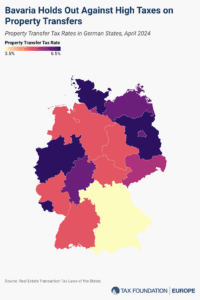
In the Shadow of T-TIP: Why Congress Should Care About EU Tax and Trade Issues in 2023
7 min readBy:There are many changes coming to Washington, D.C., now that Republicans have taken control of the U.S. House of Representatives. Uncertainty surrounds President Biden’s ability to pass his economic agenda through a divided Congress and few can predict the path U.S. taxA tax is a mandatory payment or charge collected by local, state, and national governments from individuals or businesses to cover the costs of general government services, goods, and activities. policy will take at home or abroad.
However, despite a bleak outlook for a domestic bipartisan legislative agenda, it is important for U.S. policymakers to realize that the rest of the world continues to legislate. In particular, the European Union will continue to implement tax and trade policies that affect the American economy. Without a legislative response, American consumers and companies may find themselves on the losing end of EU policies.
It is equally important for U.S. policymakers to understand why the EU has been pursuing seemingly protectionist policies such as the Carbon Border Adjustment Mechanism (CBAM) or Digital Services Taxes (DSTs), and what transatlantic policy outcomes the EU hopes to achieve with their American counterparts. Therefore, to grasp where EU policymakers are coming from, U.S. policymakers should review the theoretical underpinnings of the Transatlantic Trade and Investment Partnership (T-TIP) before racing to a tit-for-tat protectionist response.
What Was T-TIP?
The Transatlantic Trade and Investment Partnership (T-TIP) was a failed free-trade deal negotiated under the Obama administration between the United States and European Union.
According to the Office of the United States Trade Representative (USTR), T-TIP “would be a cutting-edge agreement aimed at providing greater compatibility and transparency in trade and investment regulation, while maintaining high levels of health, safety, and environmental protection.” It would also “help to promote U.S. international competitiveness, jobs and growth.”
For the European Commission, T-TIP was a tool to boost jobs and investment in the EU by reducing regulatory barriers between allies.
However, for both the U.S. and EU, there was a larger goal for T-TIP. By harmonizing “western” standards across a wide range of industries, the allies would not only ease the compliance burden on companies to boost trade and investment, but also “provide the basis for global standards.”
These standards would then be used to require other geopolitical players, like China or Russia, to abide by western standards or risk losing the ability to trade with economically powerful nations. Especially considering the World Trade Organization’s failures to enforce international trade rules, this strategy was designed to put USTR and the European Commission back in control of rules-based trade enforcement.
Why Did T-TIP Fail?
T-TIP failed for multiple reasons; however, two trends rose to the top during the negotiations and have continued to affect U.S.-EU relations ever since.
For one, the European public became skeptical of the EU’s ability to negotiate a trade deal with the U.S. that maintained what they perceived to be higher EU standards. The public feared a standards “race to the bottom” driven by U.S. companies and lack of government oversight. Therefore, it became difficult for EU policymakers to gather public support for the deal and fueled public mistrust of the American corporate community.
Secondly, President Trump came to power in 2016 and altered the direction of U.S. trade policy. Not only did the U.S. discontinue T-TIP negotiations, but the Trump administration also placed multiple tariffs on the EU. It wasn’t until November of 2021 that steel and aluminum tariffs were rolled back under President Biden.
EU Trade Strategy Post-T-TIP
Since learning domestic and international lessons from T-TIP’s failure, policymakers in Brussels have adapted their trade (and tax) strategy vis-à-vis the U.S.
The underlying premise remains the same: the EU wants to counter Chinese economic power, and protect European standards, by working with the U.S. to set global standards across industries and relying on access to its powerful economic markets to drive change in other countries.
However, the EU has adapted by realizing that, to gather domestic support for a trade deal with the U.S., the EU needs to enshrine high European standards into EU law first.
Furthermore, it is not obvious that U.S. trade strategy includes working with the EU as it did under the Obama administration. Therefore, the EU has included financial incentives (or penalties) on U.S. companies doing business in the EU with the hope of convincing the U.S. to come back to the trade deal negotiating table.
Until the U.S. returns, the EU will continue to implement European standards across industries into EU law and penalize the U.S. for not conforming. By doing so, the EU thinks it can benefit from the extra revenue from protectionist trade policies while positioning itself as the first mover in global standard-setting. It could also raise the geopolitical profile of the EU through trade and leverage the EU’s Single Market in a way that is familiar to U.S. trade officials of a previous era.
EU Issues for Congress in 2023
There are three main EU tax and trade issues that Congress should keep an eye on in 2023.
One, the EU agreed to implement a CBAM tariff that will apply to U.S. producers importing carbon-intensive goods into the EU. While the tariffTariffs are taxes imposed by one country on goods or services imported from another country. Tariffs are trade barriers that raise prices and reduce available quantities of goods and services for U.S. businesses and consumers. won’t begin until 2026, policymakers should continue working on pro-growth solutions for U.S. carbon pricing.
Second, the EU unanimously agreed to implement Pillar Two of the OECD’s global tax deal and set a 15 percent minimum tax in the EU. Most countries expect to have the ability to start taxing companies that are not paying a 15 percent rate by 2024 and this could seriously begin to impact U.S. companies in 2025 when the Undertaxed Profits Rule (UTPR) kicks in. Therefore, Congress needs to devise a strategy to either adopt Pillar Two or another domestic tax regime that avoids a complicated mess for U.S. companies.
Finally, the EU is expecting to introduce legislation to implement Pillar One sometime this year (assuming a final agreement is reached at the OECD). EU officials have made clear that if Pillar One fails in the EU or U.S., DSTs will be back on the table in the EU. Congress should consider what to do in either scenario.
In all these tax policy areas, it is essential for Congress to build a long-term strategy to support U.S. economic growth. Once Congress has a comprehensive strategy, it will be in a much stronger position to negotiate joint tax and trade ideas with the EU.
Risks to the EU Tax and Trade Strategy
While the EU sees financial penalties on U.S. companies as a way to pressure the U.S. government back to the negotiating table, it is important that the EU doesn’t overplay its hand by driving private investment away from the EU in the meantime.
According to Tax Foundation’s International Tax Competitiveness Index, many European tax codes are presently less competitive than the U.S. tax code. This means that there is already a disadvantage to companies investing in the EU relative to the U.S.
Furthermore, while subsidies for American industry certainly do not qualify as principled, pro-growth tax policy, a tipping point was seemingly exposed by the increased European temptation to move production to the U.S. to benefit from the Inflation Reduction Act tax credits.
On top of that, most of the EU’s recent tax and trade policies are not designed in a principled, pro-growth manner. CBAM, for example, does not give European producers an export rebate for carbon emissions purchased in the EU on products sold in a third country. This makes European products less competitive in foreign markets and may tempt European producers to move production of carbon-intensive goods to less burdensome jurisdictions.
In addition, depending on how EU countries implement Pillar Two, there may be U.S.-EU disputes about taxing rights on American companies in the EU.
Finally, if Pillar One is not implemented, European DSTs will return to punish mostly U.S. tech companies.
All these policies leave room for the EU to lose important private investment due to an already uncompetitive business environment and the possibility of facing punitive trade measures from the U.S. The EU would be wise to realize that European standards only matter to partners who trade with the EU, and partners will only trade or invest in the EU if economic growth is a priority.
The Future of U.S.-EU Tax and Trade
The EU’s unilateral approach with carbon taxA carbon tax is levied on the carbon content of fossil fuels. The term can also refer to taxing other types of greenhouse gas emissions, such as methane. A carbon tax puts a price on those emissions to encourage consumers, businesses, and governments to produce less of them. es, faster track on the global minimum tax, and threat of renewed efforts on DSTs means that U.S. policymakers face some hard choices. Policymakers on both sides of the Atlantic should keep in mind pro-growth tax and trade principles that promote a rules-based international order and increase opportunity.
The U.S. still has the chance to work with the EU and be a global leader on standards and free trade. However, it will require policymakers to decide who the real adversary is—the party on the other side of the aisle, the EU, or bad international actors like China and Russia. Only then will policymakers aim for solutions that put pro-growth tax and trade policy over tit-for-tat protectionism.
Share
